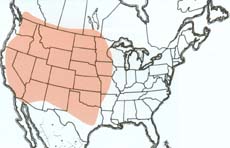Striped Sand Grasshopper
|
|
|
|
Geographic range of Melanoplus foedus Scudder |
|
|
Distribution and
Habitat
Economic
Importance
Food Habits
Dispersal and
Migration
Identification
Hatching
Nymphal
Development
Adults and
Reproduction
Population
Ecology
Daily Activity
Selected
References
The striped sand grasshopper, Melanoplus foedus, ranges widely in western North America, nearly coextensive with the range of Melanoplus packardii which it closely resembles. The habitats of these two species within their common geographic ranges differ remarkably. The striped sand grasshopper inhabits vegetated areas of sandy soils while the Packard grasshopper inhabits vegetated areas of loamy soils. Both species feed principally on forbs and both conduct most activities on the preponderant bare ground of their habitats.
A distinctive community of native plants grows in sandy soils. In addition to the widely distributed and tolerant grasses blue grama, western wheatgrass, and needleandthread, two species of tall grass are prominent, prairie sandreed and sand bluestem and one midgrass, sand dropseed. Of the many forbs, western ragweed, several species of sunflower, and several species of scurfpea are commonly present.
Economic Importance
Because of its preference for "weeds" and its normally low density in the assemblage of grasshoppers inhabiting sandy rangeland sites, the striped sand grasshopper is of minor economic importance. Nevertheless, damaging densities irrupt on the sandy rangeland of western Idaho and eastern Oregon. This species also increases to outbreak numbers in weedy land adjacent to crop land. After becoming adult the grasshoppers invade and damage fields of wheat, barley, corn, and alfalfa. The Cooperative Economic Insect Report recorded severe infestations in five states: Idaho, Nebraska, Kansas, Oklahoma, and Texas.In western Idaho an assemblage of species, mainly Melanoplus sanguinipes, M. bivittatus, and M. foedus, irrupted in 1957 reaching densities of 100 per square yard. In eastern Idaho in 1961, the striped sand grasshopper increased along roadsides to numbers averaging 8 per square yard. In 1958 in southwestern Nebraska, an assemblage of species, mainly Melanoplus sanguinipes, M. angustipennis, and M. foedus, infested margins of wheat fields at densities of 5 to 54 per square yard. No follow-up reports were made of this infestation. Presumably the grasshoppers were either controlled or they dispersed into the wheat and caused damage.
As no quantitative study of this grasshopper's impact on rangeland and crops has been made, we may estimate its importance based on its weight. It belongs to the largest third of North American grasshopper species. Live weights of five males and six females collected in sandy rangeland of southeastern Wyoming averaged 450 and 725 mg, respectively (dry weight: males 143 mg, females 238 mg).
Food Habits
The striped sand grasshopper is a highly polyphagous species that feeds on a variety of forbs, grasses, and sedges. Fifty-six species of forbs, 19 species of grasses, and 2 species of sedges have been detected in crop contents of specimens collected from sites in four states. Table I shows the common food plants of grasshoppers collected in Colorado, Idaho, Nebraska, and North Dakota. Crop analyses of specimens captured in two rangeland sites in southwestern Idaho revealed that common plants ingested were downy brome, thickspike wheatgrass, sunflower, redstem filaree, tumblemustard, and western salsify (Tragopogon dubious). Two-choice laboratory tests of striped sand grasshoppers from Wyoming showed that dandelion and green young wheat are also among its preferred food plants.
Migration and Dispersal
The striped sand grasshopper is a long-winged species with good capacity for flight. Adults observed in Idaho are wary and commonly fly 30 to 60 feet when disturbed. In this state during the dry period of summer when upland vegetation desiccates, the adults move into more mesic, ravine habitats. Movement of adults from weedy rangelands, CRP land, and field margins into crops have been reported in three western states - Idaho in 1957 and 1961, Texas Panhandle in 1959, and Oklahoma in 1973. The details of these dispersals were not investigated and mass migrations have never been reported.Observations of flushed flight in sandy native grasslands of southeast Wyoming, indicated shorter distances than in Idaho. Flight distances were 2 to 9 feet at heights of 4 to 10 inches. The flights were straight and silent with the landed grasshoppers facing in the direction of flight.
The nymphs have not been observed to disperse extensively or to migrate. Apparently they complete nymphal development in the habitat of their hatching.
Identification
|
Figures 1-5.
Appearance of the five nymphal instars of Melanoplus foedus, their
sizes, structures, and color patterns. Notice progressive development of the
small wing pads. BL = body length, FL = hind femur length, AS = number of
antennal segments. |
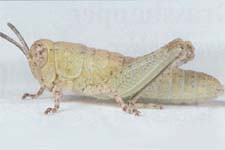 |
|
Fig. 1, First Instar:BL 5.4 mm FL 3.2 mm AS
13. |
 |
|
Fig. 2, Second Instar:BL 5.7-7.8 mm FL 3.4-4 mm AS
16-18. |
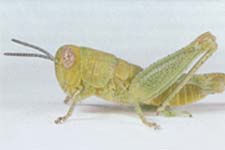 |
|
Fig. 3, Third Instar:BL 8-13.1 mm FL 5.8-8.4 mm AS
19-23. |
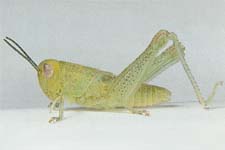 |
|
Fig. 4, Fourth Instar:BL 14-16 mm FL 9.5-10.5 mm AS
23-25. |
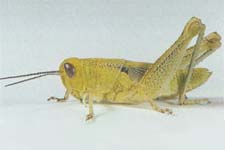 |
|
Fig. 5, Fifth Instar:BL 18.2-20.2 mm FL 12-13.5 mm AS
25-26. |
|
Figures
6-10,Appearance of the adult male and female of Melanoplus foedus,
dorsal view of head and pronotum, cercus of the male, egg pod and
eggs. |
 |
|
Fig. 6, Adult Male:BL 25-28
mm FL 13.5-14.8 mm AS 25-27. |
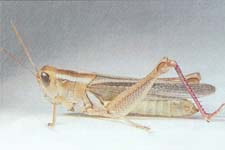 |
|
Fig. 7, Adult Female:BL 26-35 mm FL I4.5-17.5 mm AS
26-27. |
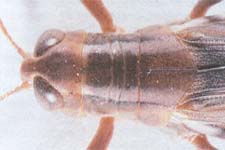 |
|
Fig. 8, Dorsal view of head and pronotum of a
female. |
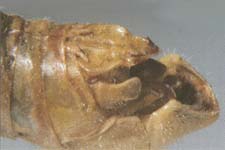 |
|
Fig. 9, End of male abdomen showing cercus, furcula, and
supraanal plate. |
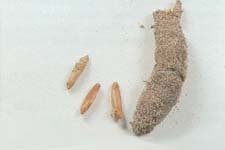 |
|
Fig. 10, Egg pod and
three loose eggs. |
The striped sand grasshopper is a large, usually colorful species equaling in size and resembling in color patterns the closely related Packard grasshopper, Melanoplus packardii. A broad brown band runs down the top of head and center of the pronotum, On each side of this band is a pale yellow stripe (Fig. 8) to which the common name refers. Variations in color, however, occur among populations of adult striped sand grasshoppers. In the sandy sites of eastern Wyoming and Colorado adults are bright yellow and brown with contrasting bars and stripes (Fig. 6 and 7); in the rangeland of eastern.
Oregon, adults are dull pale tan with faint bars and stripes. The wings are long and extend 1 to 4 mm beyond the apex of the hind femora. Tegmina are usually unspotted. The outer medial area of the hind femur is either solid fuscous or pale yellow and spotted fuscous; the inner medial area is bright yellow. In Wyoming and Oregon the hind tibia is usually red but farther north it is blue. As the striped sand grasshopper and the Packard grasshopper are superficially alike, definite identification depends on differences of the aedeagus. The valves of the Packard grasshopper are equally short; the outer valve of the striped sand grasshopper is short, the medial valve is long, clearly extending beyond the tip of the outer valve (Fig. II).
The nymphs are identifiable by their structures, color patterns and shape (Fig. 1-5).
- Head with face nearly vertical, color green, sparsely spotted fuscous, spots more numerous on top and front of head; compound eye with relatively large tan spots; antennae filiform and predominantly fuscous,each segment ringed anteriorly pale gray.
- Pronotum mostly green, disk of pronotum green or pale tan and spotted fuscous, lobes unspotted or sparsely spotted.
- Outer medial area of hind femur green with three rows of spots or nearly spotless; hind tibia pale green or pale gray.
Apparently the color of nymphs varies, as those collected in Colorado and Wyoming are green, while those found in western Idaho are predominantly pale brown or tan and only a few are green. Because of the difficulty of separating nymphs of M. foedus from M. packardii one may tentatively call nymphs collected in sandy soil M. foedus and then return later to the site to capture adult males for confirmation using the distinguishing structure of the aedeagus.
Hatching
The striped sand grasshopper is an early hatching species. Nymphs first appear about two weeks after Cordillacris occipitalis and about the same time as Melanoplus sanguinipes. All three species often occupy the same sandy soil habitat. In southeastern Wyoming (elevations 4,100 to 5,000 ft), hatching begins usually in mid May, however, actual dates of hatching have ranged from May 1 to 29. After the first nymphs appear, hatching continues for two weeks. In southwestern Idaho and in the sandhills prairie of southeastern North Dakota hatching occurs in late May and early June.
Nymphal Development
Nymphs develop in late spring when temperatures are mild and cool-season grasses and forbs are still green and nutritious. In southeastern Wyoming, the nymphal period lasts approximately 40 days from mid May to late June. Based on initial appearance of instar I and first adults, the nymphal stage has been estimated to range from 34 to 42 days. In the sandy study site 5 mi south of Guernsey, Wyoming, calculated nymphal periods were 34 days in 1975 and 1981, 37 days in 1977, and 42 days in 1979.
Adults and Reproduction
In sandy soil habitats of southeastern Wyoming, adults are present during the summer months from late June through September. In favorable rangeland sites, they appear to remain lifelong, but whenever the habitat deteriorates due to drought, they move to nearby areas with green vegetation such as swales, ravines, and irrigated land.No special studies of maturation, courtship, or fecundity of this grasshopper have been made. A few field observations have been noted that provide incidental information. In a study site in northeast Laramie County, Wyoming on 18 August 1999 at 8:17 am DST (soil 81°F, air 76°F, sky clear), a male made courtship overtures of femur shaking as he faced a female 6 inches away. Before the male could make contact, the female was frightened away by an inquisitive cowboy on horseback.
In a study site 5 miles west of Torrington, Wyoming, a female was observed on 27 July 1991 at 11:24 am (soil 120°F, air 86°F, sky clear) to begin boring into bare ground but after 1 minute she ceased and walked away. The number of days from fledging to this ovipositing behavior was estimated to be 26. In a study site of southeast Goshen County, Wyoming, two females were observed ovipositing into bare soil at the side of a ranch road on 25 August 1993 at 12:30 pm. In a study site south of Guernsey, Wyoming, a female was discovered ovipositing into bare soil at 4:06 pm, 17 August 1990 (soil 101°F, air 86°F, sky clear).
Females confined with males in laboratory cages were provided plastic trays of sandy soil for oviposition. The females readily found the sandy soil and deposited most eggs into this medium. A few eggs however, were deposited on the screen floor of the cage. One female was discovered ovipositing into the soil at 11:15 am on 3 August 1992. After removing her ovipositor from the soil she moved the end of her ovipositor sideways and back and forth to brush soil over the exit hole.
The pods contained from 16 to 30 tan eggs (Fig 10). Eggs were 4.8 to 5.1 mm long, the pods 1/2 to 3/4 inch long
Population Ecology
The striped sand grasshopper fluctuates in density over the years much like other pest grasshoppers of the genus Melanoplus. Recorded outbreaks usually consisted of several species in the assemblage. Prominent coinhabitants include Melanoplus bivittatus, M. sanguinipes, and M. angustipennis. The absolute density of each species in these assemblages has not been reported. At times M.foedus, essentially alone, may irrupt and become the sole cause of a moderate outbreak. Such an outbreak occurred in 1961 in the vicinities of Victor and Swan Valley, Idaho. The grasshoppers increased along roadsides to densities averaging 8 per square yard.In Wyoming native grassland, densities of M. foedus have remained low, even during years of outbreaks. In the longest studied site, a sandy soil habitat 5 miles south of Guernsey, Wyoming, monitored for 12 years, 1975 to 1986, populations of M. foedus fluctuated in density from less than 0.1 to 1.0 per square yard. At its highest density of 1 per square yard M. foedus was subdominant to M. sanguinipes which had risen to a density of 3.6 per square yard. Populations of M. foedus in a study site of northeast Laramie County have remained small with estimated densities of 1.3 per square yard for three years, 1999 to 2001.
Over their large geographic ranges the two closely related species M. foedus and M. packardii, do not, as a rule, occupy the same habitats. Exceptions, however, occur. In the Pine Ridge of the Nebraska Panhandle, pure populations of M. foedus were found on grass covered ridges while at the bottom this species was often mixed with M. packardii.
Although how populations of the striped sand grasshopper grow to outbreak densities remains undocumented, the reports of damaging assemblages of grasshoppers in Idaho and Nebraska indicate that under environmental condition fostering increases of other species of the genus, especially M. bivittatus and M. sanguinipes which have been studied thoroughly, M. foedus is similarly affected. By inference, mild spring weather, adequate but gentle rainfall, a steady supply of preferred food plants, few predators, and little disease all interact to promote population growth of M. foedus.
Daily Activity
At night in its native rangeland habitat, the striped sand grasshopper shelters on the ground under canopies of grasses and forbs. In disturbed weedy sites, however, it climbs tall plants such as kochia, Russian thistle, sunflower, and sweet clover; it rests vertically, head up, usually on the main stem, at heights of 12 to 24 inches.In early August in rangeland of southeast Wyoming, adults emerge from shelter and begin to bask 1 hour after sunrise (soil and air temperatures 50°- 60°F). They continue basking for about 3 hours (at end of basking: soil 100°-110°F and air 80°-85°F). In basking they sit horizontally on bare ground and take a flanking posture by turning a side perpendicularly to rays of the sun and lowering the hindleg to expose the abdomen. On sunny days, adults spend most of their morning basking, but during this period they also conduct other activities. They have been observed to crawl, feed, court, and oviposit. They discontinue basking at high temperatures but remain on the soil surface and assume a variety of postures to reduce further insolation. As temperatures rise still higher (soil 115°F air 95°F), the grasshoppers take evasive action by climbing grass or forb stems to heights of 2 to 6 inches or they crawl into the shade of vegetation. When temperatures ameliorate in late afternoon, the grasshoppers resume daily activities. As temperatures cool still further, they bask for a second time. Finally around sunset, they retreat to their night time shelters.
The daily routine of activities of adults roosting on tall plants is remarkably different from that of ground residents. In the morning they bask by adjusting their positions on the plants and adopting a flanking posture or a dorsal posture, remaining vertical, head up. Later they feed on the host plant and when temperature of the habitat rises above their preferendum, they adjust their positions on the plant. At times they move to the ground, particularly for oviposition, but evidently also for other purposes. In the site 5 miles west of Torrington, Wyoming, between 6 and 6:34 am on 26 July 1991, one adult was discovered on the ground while five adults were found roosting on tall vegetation.
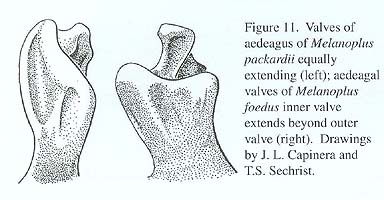
Selected References
Banfill, J.C. and M.A. Brusven. 1973. Food habits and ecology of grasshoppers in the Seven Devils Mountain and Salmon River breaks of Idaho. Melanderia 12: 1-21.Hagen, A.F. 1970. An annotated list of grasshoppers (Orthoptera, Acrididae) from the eleven panhandle counties of Nebraska. Nebraska Agr. Exp. Stn. Research Bull. 238.
Joern, A. 1985. Grasshopper dietary (Orthoptera: Acrididae) from a Nebraska Sand Hills prairie. Transactions Nebraska Acad. Sci. 13: 21-32.
Ueckert, D.N. and R.M. Hansen. 1971. Dietary overlap of grasshoppers on sandhill rangeland in northeastern Colorado. Oecologia 8: 276-295.
